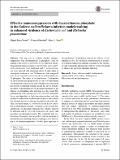Files in this item
Effective immunosuppression with dexamethasone phosphate in the Galleria mellonella larva infection model resulting in enhanced virulence of Escherichia coli and Klebsiella pneumoniae
Item metadata
| dc.contributor.author | Perez Torres, Miquel | |
| dc.contributor.author | Entwistle, Frances | |
| dc.contributor.author | Coote, Peter John | |
| dc.date.accessioned | 2016-03-23T16:00:05Z | |
| dc.date.available | 2016-03-23T16:00:05Z | |
| dc.date.issued | 2016-08 | |
| dc.identifier | 240937709 | |
| dc.identifier | 4613f80d-5bde-4fc1-9c6c-d08a84104d6f | |
| dc.identifier | 84975682948 | |
| dc.identifier | 000379699400005 | |
| dc.identifier.citation | Perez Torres , M , Entwistle , F & Coote , P J 2016 , ' Effective immunosuppression with dexamethasone phosphate in the Galleria mellonella larva infection model resulting in enhanced virulence of Escherichia coli and Klebsiella pneumoniae ' , Medical Microbiology and Immunology , vol. 205 , no. 4 , pp. 333-342 . https://doi.org/10.1007/s00430-016-0450-5 | en |
| dc.identifier.issn | 0300-8584 | |
| dc.identifier.other | ORCID: /0000-0001-5190-805X/work/40963219 | |
| dc.identifier.uri | https://hdl.handle.net/10023/8475 | |
| dc.description | MPT was the recipient of an ERASMUS training grant. FE is supported by the University of St Andrews. | en |
| dc.description.abstract | The aim was to evaluate whether immunosuppression with dexamethasone 21-phosphate could be applied to the Galleria mellonella in vivo infection model. Characterised clinical isolates of Escherichia coli or Klebsiella pneumoniae were employed, and G. mellonella larvae were infected with increasing doses of each strain to investigate virulence in vivo. Virulence was then compared with larvae exposed to increasing doses of dexamethasone 21-phosphate. The effect of dexamethasone 21-phosphate on larval haemocyte phagocytosis in vitro was determined via fluorescence microscopy and a burden assay measured the growth of infecting bacteria inside the larvae. Finally, the effect of dexamethasone 21-phosphate treatment on the efficacy of ceftazidime after infection was also noted. The pathogenicity of K. pneumoniae or E. coli in G. mellonella larvae was dependent on high inoculum numbers such that virulence could not be attributed specifically to infection by live bacteria but also to factors associated with dead cells. Thus, for these strains, G. mellonella larvae do not constitute an ideal infection model. Treatment of larvae with dexamethasone 21-phosphate enhanced the lethality induced by infection with E. coli or K. pneumoniae in a dose- and inoculum size-dependent manner. This correlated with proliferation of bacteria in the larvae that could be attributed to dexamethasone inhibiting haemocyte phagocytosis and acting as an immunosuppressant. Notably, prior exposure to dexamethasone 21-phosphate reduced the efficacy of ceftazidime in vivo. In conclusion, demonstration of an effective immunosuppressant regimen can improve the specificity and broaden the applications of the G. mellonella model to address key questions regarding infection. | |
| dc.format.extent | 11 | |
| dc.format.extent | 1726337 | |
| dc.language.iso | eng | |
| dc.relation.ispartof | Medical Microbiology and Immunology | en |
| dc.subject | Insect infection model | en |
| dc.subject | Antibacterial | en |
| dc.subject | Antimicrobial | en |
| dc.subject | Ceftazidime | en |
| dc.subject | Pathogenicity | en |
| dc.subject | Glucocorticoid anti-inflammatory | en |
| dc.subject | QR Microbiology | en |
| dc.subject | QR180 Immunology | en |
| dc.subject.lcc | QR | en |
| dc.subject.lcc | QR180 | en |
| dc.title | Effective immunosuppression with dexamethasone phosphate in the Galleria mellonella larva infection model resulting in enhanced virulence of Escherichia coli and Klebsiella pneumoniae | en |
| dc.type | Journal article | en |
| dc.contributor.institution | University of St Andrews. School of Biology | en |
| dc.contributor.institution | University of St Andrews. Biomedical Sciences Research Complex | en |
| dc.identifier.doi | 10.1007/s00430-016-0450-5 | |
| dc.description.status | Peer reviewed | en |
This item appears in the following Collection(s)
Items in the St Andrews Research Repository are protected by copyright, with all rights reserved, unless otherwise indicated.

